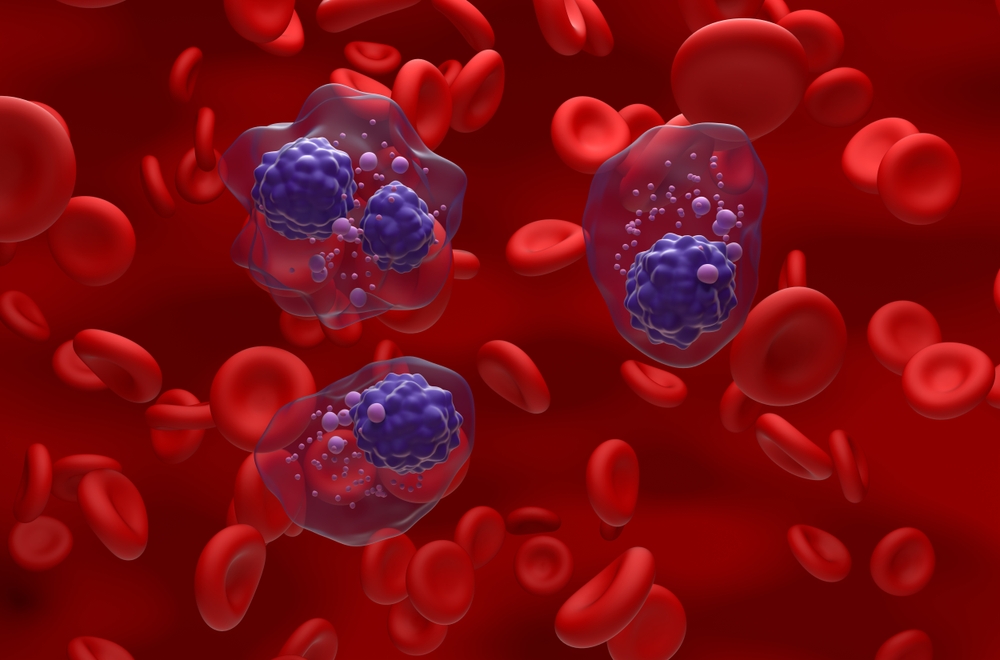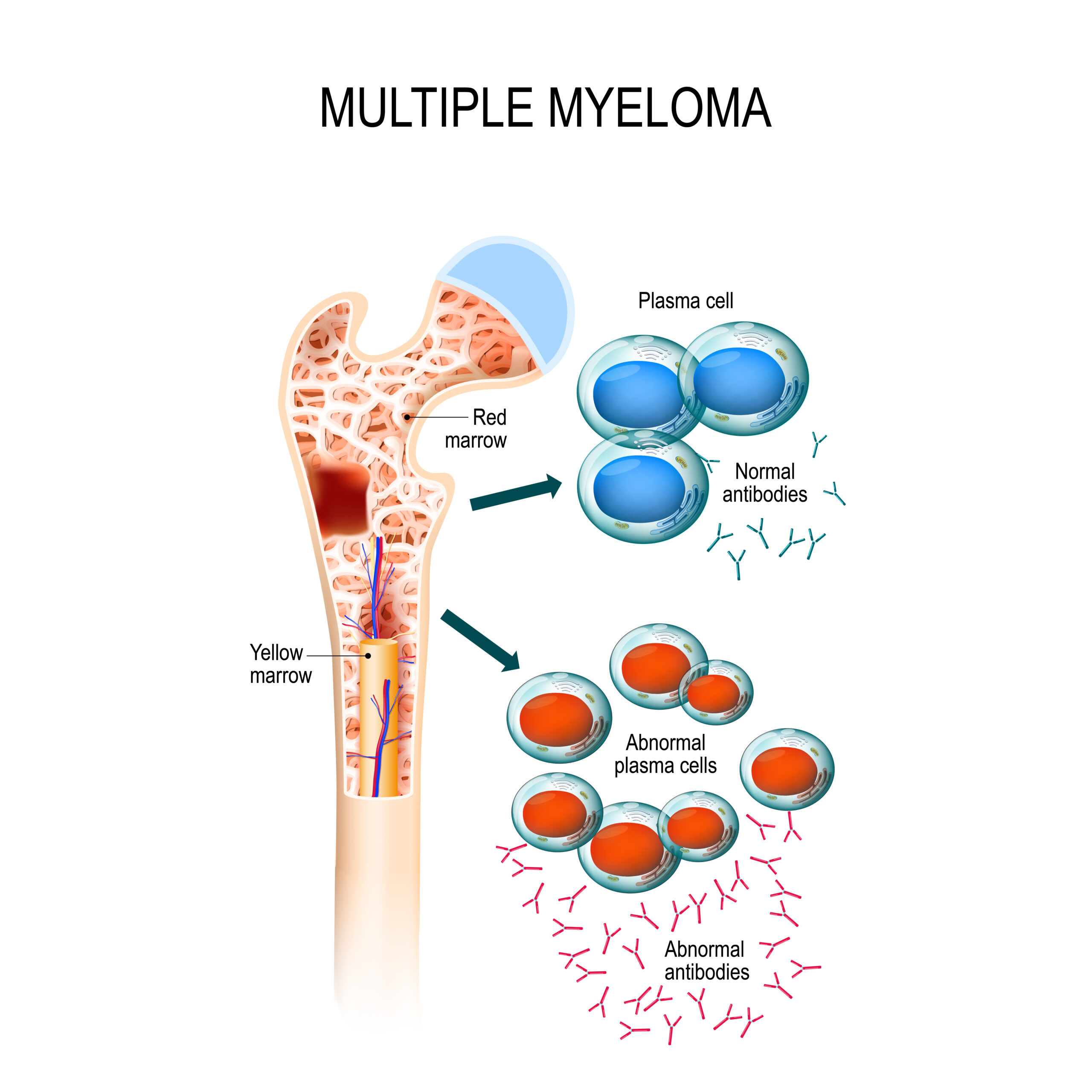Let's talk about multiple myeloma. It might sound complicated, but it’s a type of cancer attacking bone marrow – think of this as the squishy tissue tucked away inside your bones. Now, here comes its important job: making blood cells.
Among these are some white blood cells known as B lymphocytes, which usually have the power to transform into plasma cells and produce antibodies – protective proteins ready for battle against intruders like viruses in our bodies.
Multiple myeloma develops due to abnormalities transforming B lymphocytes into plasma cells in the bone marrow. Cancerous transformation of plasma cells results in their uncontrolled multiplication and secretion of large amounts of abnormal antibodies. These abnormal antibodies don't work. At the same time, myeloma reduces the number of normal plasma cells and normal antibodies, making people with myeloma more prone to infections. Excessive numbers of these antibodies cause myeloma symptoms, such as bone pain or kidney damage. Also, too many plasma cells crowd out other cells in the bone marrow – including cells responsible for producing red blood cells and platelets, which causes their deficiency in the body.
Typically, plasma cells are different from each other and produce different types of antibodies – so they are polyclonal. Abnormal plasma cells come from one abnormal cell – therefore, they secrete the same form of immunoglobulin and are called monoclonal.

Multiple myeloma is not a common disease. It accounts for 1.8%![]() of newly diagnosed cancers annually in the United States. It is diagnosed slightly more often in men than in women and is most common among people over the age of 70. According to the CDC, this type of cancer is almost twice as common
of newly diagnosed cancers annually in the United States. It is diagnosed slightly more often in men than in women and is most common among people over the age of 70. According to the CDC, this type of cancer is almost twice as common![]() among African Americans compared to other races.
among African Americans compared to other races.
In multiple myeloma, symptoms are caused by the growth of cancer cells and the antibodies they produce:
During multiple myeloma, various changes occur in the body.

The cause of the disease is unknown. A role in its development is attributed to genetic factors![]() and long-term antigen stimulation (antigens are triggers such as microorganisms) in bacterial or viral infections. Long-term exposure to radiation, insecticides, benzene, and other toxic substances used in the chemical industry may be significant.
and long-term antigen stimulation (antigens are triggers such as microorganisms) in bacterial or viral infections. Long-term exposure to radiation, insecticides, benzene, and other toxic substances used in the chemical industry may be significant.
Multiple myeloma usually develops in stages. As a result of the mutation, an immortal plasma cell is created. It begins to divide and produce monoclonal antibodies. This stage is called monoclonal gammopathy of undetermined significance (MGUS). This stage may or may not progress further and lead to multiple myeloma.
The risk factors for getting multiple myeloma include:
Diagnosing multiple myeloma requires scrutiny involving a review of symptoms, a physical exam, and supplemental tests. Confirming the presence or absence of this disease necessitates thorough testing – from blood work to urine samples and imaging procedures. Each patient with suspected multiple myeloma must navigate through these extensive examinations. Following confirmation, further assessments are required to evaluate the cancer’s stage, which helps determine treatment options.
Blood analysis performed when myeloma is suspected includes complete blood count, creatinine level, protein level, calcium level, and lactate dehydrogenase (LDH).![]()
Characteristic results in blood tests in the course of myeloma are increased levels of calcium and protein with the presence of antibodies typical for myeloma. The concentration of beta-2-microglobulin (a protein found in the plasma cells) is also assessed to estimate the disease's advancement and aggressiveness. Additionally, anemia and a decrease in the number of platelets are observed.
A urinalysis is performed to inform your doctor about how your kidneys function. Therefore, creatinine, urea, and calcium levels are tested. Proteinuria (a large amount of protein in the urine) is common in advanced disease. The level of Bence-Jones protein, which consists of parts of antibodies filtered through urine, is also checked. To test your Bence-Jones protein![]() level, your doctor may ask you to collect your urine at home for 24 hours.
level, your doctor may ask you to collect your urine at home for 24 hours.
Scans (X-rays or CT scans) of almost the entire skeletal system (skull, spine, sternum, ribs, pelvis, arm, and leg bones) are performed to determine whether the cancer caused bone damage![]() . Such examination should be performed on every patient diagnosed with multiple myeloma because the diagnosis of bone damage may have an impact on the treatment.
. Such examination should be performed on every patient diagnosed with multiple myeloma because the diagnosis of bone damage may have an impact on the treatment.
Other scans performed in myeloma are magnetic resonance imaging (MRI) and positron emission tomography (PET) scans. These tests are performed to look for individual groups of abnormal plasma cells in the body.
A bone marrow biopsy reveals the size of plasma cell infiltrates and determines the percentage of cancer cells in the marrow. The marrow is usually harvested from the hip bone or sternum![]() .
.
The biopsy is performed using a special needle. After local anesthesia, the needle is inserted through the skin, subcutaneous tissue, and bone. When the needle is in the center of the bone, the doctor connects a syringe to which the bone marrow is aspirated. The collected bone marrow is quickly placed in test tubes and microscope slides. The entire procedure takes a few minutes. The sample looks like blood but also contains small lumps of bone marrow. Typically, several milliliters of bone marrow are collected.
Based on the obtained results, the doctors can distinguish the stage of multiple myeloma. They use a three-point scale![]() to evaluate the result of beta-2-microglobulin levels, albumin (protein) levels, and LDH levels. The stage of myeloma tells the doctors how quickly the cancer is growing. At stage 1, myeloma is slowly increasing, and at stage 3, it spreads fast.
to evaluate the result of beta-2-microglobulin levels, albumin (protein) levels, and LDH levels. The stage of myeloma tells the doctors how quickly the cancer is growing. At stage 1, myeloma is slowly increasing, and at stage 3, it spreads fast.
In addition to multiple myeloma, tests can also detect:
These are pre-cancerous diseases that may or may not develop into cancer. In such a case, further observation and regular examinations are recommended to initiate treatment immediately if the condition develops.
However, monoclonal antibodies do not always indicate cancer or pre-cancerous disease. Monoclonal antibodies can be detected in other conditions, e.g., autoimmune, rheumatological, or infectious.
Myeloma is a disease with various forms. Full-blown multiple myeloma is most often a disease of the entire body, with a chronic course. But sometimes, it may also take the form of an isolated tumor. The form of the disorder has a crucial impact on the treatment method, but equally important factors are the patient's age, general condition, and other diseases.
Treatment options![]() for multiple myeloma include:
for multiple myeloma include:
Indications for drug treatment – chemotherapy and the administration of other drugs are the diagnosis of symptomatic multiple myeloma. In recent years, many new medications have been introduced that work differently than traditional chemotherapy.
Corticosteroids are also used in therapy. They work by enhancing the effects of chemotherapy and helping to destroy cancer cells.

Eligible patients are treated with very high doses of drugs that are intended to destroy more cancer cells. This does not result in a complete cure but allows for a more extended period of remission, i.e., when the disease does not cause symptoms. However, such high doses of drugs do not only affect myeloma cells but also destroy healthy bone marrow. Therefore, after such treatment, a stem cell transplant![]() is necessary to rebuild the damaged bone marrow.
is necessary to rebuild the damaged bone marrow.
There are two types of stem cell transplant:
Currently, multiple myeloma is considered an incurable disease. However, the increasingly better knowledge about this disease and the introduction of new, targeted groups of drugs allow for achieving remission and extending the life expectancy of patients.
According to the National Cancer Institute, the 5-year survival rate for myeloma patients is 60%![]() . However, subsequent disease relapses worsen the treatment results. The most common cause of death during the disease is infection.
. However, subsequent disease relapses worsen the treatment results. The most common cause of death during the disease is infection.
There is no known way of preventing multiple myeloma as the cause of the disease is unknown. However, the factors linked to its development include exposure to radiation, insecticides, and other toxic chemicals, so staying clear of these factors is recommended.
If you experience any symptoms of multiple myeloma, such as bone pain, especially in the lumbar area, incredible fatigue, weight loss, muscle weakness, or fever of unknown origin, you should contact your GP. Your doctor will order proper tests and, if necessary, refer you to an appropriate specialist. A specialist in the treatment of blood diseases is called a hematologist.